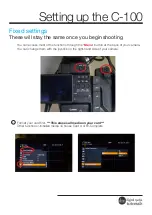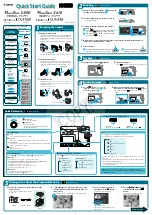
Pike
Technical
Manual
V5.2.3
188
Controlling image capture
Controlling
image
capture
Jitter at start of exposure
The
following
chapter
discusses
the
latency
time
which
exists
for
all
Pike
CCD
models
when
either
a
hardware
or
software
trigger
is
generated,
until
the
actual
image
exposure
starts.
Owing
to
the
well-known
fact
that
an
Interline
Transfer
CCD
sensor
has
both
a
light
sensitive
area
and
a
separate
storage
area,
it
is
common
to
interleave
image
exposure
of
a
new
frame
and
output
that
of
the
previous
one.
It
makes
continuous
image
flow
possible,
even
with
an
external
trigger.
The
uncertain
time
delay
before
the
start
of
exposure
depends
on
the
state
of
the
sensor.
A
distinction
is
made
as
follows:
FVal
is
active
the
sensor
is
reading
out,
the
camera
is
busy
In
this
case
the
camera
must
not
change
horizontal
timing
so
that
the
trigger
event
is
synchronized
with
the
current
horizontal
clock.
This
introduces
a
maximum
uncertainty
which
is
equivalent
to
the
line
time.
The
line
time
depends
on
the
sensor
used
and
therefore
can
vary
from
model
to
model.
FVal
is
inactive
the
sensor
is
ready,
the
camera
is
idle
In
this
case
the
camera
can
resynchronize
the
horizontal
clock
to
the
new
trigger
event,
leaving
only
a
very
short
uncertainty
time
of
the
master
clock
period.
Model
Exposure start jitter
(while FVal)
Exposure start jitter
(while camera idle)
Pike
F-032
4.9
µs
375
ns
Pike
F-100
8.2
µs
1.65
µs
Pike
F-145
16
µs
2.9
µs
Pike
F-145-15fps
30
µs
5.4
µs
Pike
F-210
14.25
µs
1.8
µs
Pike
F-421
15
µs
1.65
µs
Pike
F-505
17
µs
5.7
µs
Pike
F-1100
single
tap:
141
µs
dual
tap:
74.5
µs
7.64
µs
(dual
tap)
Pike
F-1600
single
tap:
177
µs
dual
tap:
95.7
µs
13.6
µs
(dual
tap)
Table 79: Jitter at exposure start (no binning, no sub-sampling)
Note
•
Jitter
at
the
beginning
of
an
exposure
has
no
effect
on
the
length
of
exposure,
i.e.
it
is
always
constant.
















































